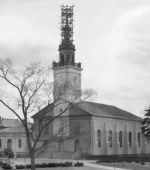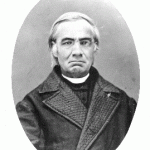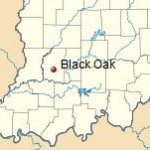This is a long post, but only because I am a bit behind and the items I want to mention are important, so four posts coming in two…
The first item is the dedication of the present St. Francis Xavier Church in Vincennes. On August 8, 1841 Bishop Celestine de la Hailandiere officially dedicated this structure. Even though the church was built much earlier, what we now call the “Old Cathedral” was finally dedicated on this day by Bishop Hailandiére.
On March 30, 1826 the Vincennes Sun reported:
The cornerstone of the Catholic Cathedral, in this place, was laid on Thursday the 30th by the Rev. Mr. Champomier. A numerous concourse of citizens attended to witness the ceremony”
Vincennes was then mission country and there wasn’t much to the building itself. Bishop Brute, when he arrived in the Fall of 1834, wrote:
“The Cathedral church, a plain brick building 115 feet long and 60 broad, consisting of the four walls and the roof, unplastered and not even white-washed, no sanctuary, not even a place for preserving the sacred vestments.”
Brute worked on the building, but in those early days there were many more things to concentrate on. The completion of the building was left to Brutés successor, Bishop Hailandiére. He collected funds and used his own money to complete the church,  adding the tower and a bell. He completed the interior of the building and added the basement chapel, which includes the place where All the Bishops of Vincennes are buried.
adding the tower and a bell. He completed the interior of the building and added the basement chapel, which includes the place where All the Bishops of Vincennes are buried.
The Church has a long history. In the 1930’s, prior to the celebration of the centennial of the Diocese of Indianapolis (of which Vincennes was still a part) a great deal of work was done on the Cathedral and allied buildings. The “HABS” (Historic American Buildings Survey) made an effort to document the repairs and the history of the structure itself. They produced a number of pictures, one of which, shown here, shows the repairs that were being made to the steeple. Take a look at the full image here
In 1970 it was elevated to the status of a basilica. Today it remains an important part of the Diocese of Evansville. The adjoining Brute Library contains some of the rarest books in America.
An aside… I found an article in a Logansport Newspaper from 1881. In it, the writer talks about his visit to Vincennes, and he mentions the church saying:
“The first church was founded by Francis Xavier and a building erected of logs, “daubed” with clay and prairie hay, and covered with A thatched roof. How our imagination ran back to 1747 to see walking down the aisle of this rude church a happy bride””happy as brides of to-day are””only a year later to be buried beneath this same aisle.”
One would think that the Jesuits would be interested in knowing that Saint Francis Xavier had founded a church in Indiana…
On the very same day that Bishop Hailandiére was dedicating the new Cathedral in Vincennes a band of Religious men left the shores of their native France headed for the wilds of Indiana.  Their final location wasn’t really known at this time. The second Bishop of Vincennes, Celestine de la Hailandiere, was waiting for their arrival.
Their final location wasn’t really known at this time. The second Bishop of Vincennes, Celestine de la Hailandiere, was waiting for their arrival.
On August 8, 1841 Father Edward Sorin and a band of Holy Cross Brothers left LeHavre, France on the ship “Iowa” headed for New York and ultimately, Vincennes and Notre Dame du Lac.
Initially, Bishop Hailandiere tried to interest Fr. Sorin and his band in land that was owned in St. Francisville, Illinois. Sorin nixed that and then agreed to build his boys school in what was known as “Black Oak Ridge”,  which is now the area near Montgomery in Daviess County. This arrangement apparently went sour over time and Sorin chose to take up the Bishop’s other offer to settle on the land that had been owned by Fr. Stephen Badin, the first priest ordained in the United States, who worked among the Native Americans in the area.
which is now the area near Montgomery in Daviess County. This arrangement apparently went sour over time and Sorin chose to take up the Bishop’s other offer to settle on the land that had been owned by Fr. Stephen Badin, the first priest ordained in the United States, who worked among the Native Americans in the area.
Fr. Gorman writes:
Curiously, the bishop first offered Sorin the property at St. Francisville, accompanying him there to inspect it. Sorin, having rejected this offer, went
with Delaune to St. Peter’s which he agreed to accept immediately and the Brothers occupied the buildings on October l, 1841. On the site, in the middle
of a forest, was a little chapel with a sacristy and room for the priest, and, two log cabins, one used for a kitchen and the other for a school. One of the
latter, “a log house open to all the winds” and with extremely poor furnishings became the first mother house of Holy Cross in America. Sorin’s task, as outlined
by the bishop was to care for the Catholics within a five mile radius of St Peter’s with the missions of St. Patrick, St. Mary and Mt. Pleasant; to build a school for boys and to construct a novitiate for priests… Sorin began his pastoral labor. About a week after their establishment a notice appeared in a Washington paper that the Brothers of St. Joseph were ready to receive students and the Catholic almanac for 1842 contained a similar announcement.Sorin caught the idea which he was to hold with steady tenacity throughout his life – the establishment of a college. This is clearly indicated in an advertisement inserted in the Catholic almanac for 1842 which probably came to the attention of the bishop in the late summer of 1842. De la Hailandiere
summoned Sorin to Vincennes and, follling his policy of prohibiting competitive institutions, forbade the establishment of a college at St. Peter’s because St. Gabriel’s in Vincennes could not make ends meet. This, however, was only the culmination of a series of disagreements dating from the original misunderstanding about financing the foundation of Holy Cross. After several fruitless interviews, the bishop, in October, 1842, suggested the establishment of a college on Badin’s old property near South Bend. In spite of the difficulties which the bishop said were greater than he faced at St. Peter’s, Sorin, with the consent of the Brothers, accepted the proposal which had two obvious advantages: they would become owners and they would be so far from Vincennes that there would be comparatively little interference with their plans. 1
Thus the beginning of today’s University of Notre Dame.
- Fr. Robert Gorman, Unpublished History of the Catholic Church in Indiana[↩]